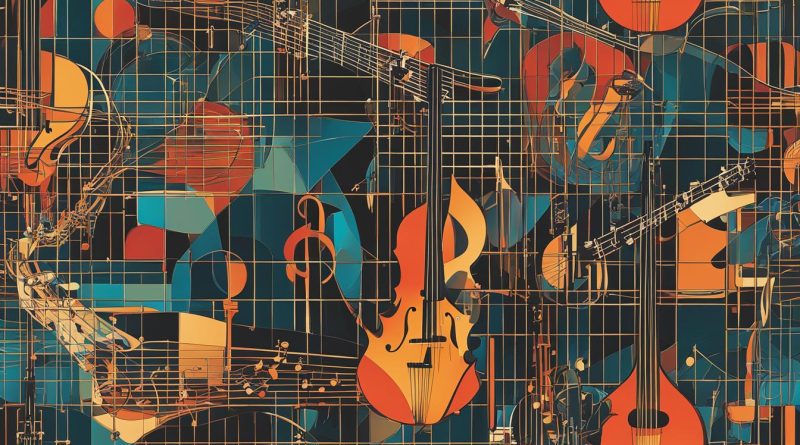Exploring Jazz Chord Progressions for Musicians
Jazz chord progressions can be a daunting subject for many musicians, but they are essential for those looking to expand their musical repertoire and creativity. Understanding the principles behind jazz chord progressions can lead to endless opportunities for musical expression.
In this article, we’ll delve into the intricacies of jazz chord progressions, exploring the foundational concepts, and providing practical applications. Whether you’re a beginner or an experienced musician, this article will provide a comprehensive overview of jazz chord progressions and help you take your musical creativity to the next level.
Key Takeaways:
- Jazz chord progressions are fundamental to expanding musical repertoire and creativity.
- Understanding the principles behind jazz chord progressions can lead to endless opportunities for musical expression.
- Beginner and experienced musicians alike can benefit from exploring jazz chord progressions.
- Common jazz chord progressions, like the ii-V-I and blues progression, are practical applications for musicians to master.
- Mastering jazz chord progressions can elevate musicians’ improvisation and composition skills.
Understanding Jazz Chord Progressions
To truly master jazz, one must understand the intricacies of jazz chord progressions. Unlike other genres, jazz utilizes extended chords, chord substitutions, and other unique characteristics that make it a complex and exciting genre for musicians.
Extended chords are chords that include notes beyond the fundamental triad. For example, a seventh chord includes the seventh note in addition to the notes from the triad. These extended chords give the music a richer, more complex sound.
Chord substitutions involve replacing a chord or chord progression with another chord or progression that shares similar harmonic qualities. This technique can be used to add variety and interest to a piece of music.
Understanding these foundational concepts is essential for mastering jazz chord progressions. Through exploration and practice, musicians can develop a deeper appreciation and understanding of jazz music and its unique characteristics.

“Jazz music is not just a music genre, it’s a way of life. Understanding the complex harmony and chord progressions is essential for any musician who wants to master this art form.” – John Coltrane
Common Jazz Chord Progressions to Master
Learning jazz chord progressions is crucial for musicians who want to expand their musical repertoire. Here are some of the most common and popular jazz chord progressions:
| Progression | Chords |
|---|---|
| ii-V-I | Minor 7th, dominant 7th, major 7th |
| Blues Progression | 12-bar blues using dominant 7th chords |
| Modal Progressions | Extended chords, such as major 7th, dominant 7th, minor 7th, and minor/major 7th chords |
Note: There are many variations and alterations that can be made to these progressions, but learning the foundation and principles behind them is important before experimenting.
By incorporating these common jazz chord progressions into their compositions and improvisations, musicians can enhance their creative abilities and add depth to their musical performances.

How to Master Jazz Chord Progressions
Mastering jazz chord progressions requires a combination of theoretical understanding and practical application. Musicians can start by learning the basic chords and scales used in jazz music, and then progressing to more complex chord voicings and substitutions.
“By playing jazz, you learn how to improvise. You learn how to work with others. You learn how to be creative.”
– Herbie Hancock
Like any other skill, mastering jazz chord progressions takes time and practice. But with dedication and hard work, musicians can unlock new levels of musical creativity and expression.
Conclusion
Understanding and mastering jazz chord progressions can greatly enhance a musician’s creativity and musical repertoire. By exploring the foundational concepts behind jazz chord progressions, musicians can gain a comprehensive understanding of the theory and principles behind them.
This article has provided an overview of what jazz chord progressions are, why they are important, and a selection of common progressions to master. Musicians are encouraged to continue experimenting with jazz chord progressions and exploring further avenues for musical expression.
Whether composing or improvising, incorporating jazz chord progressions can elevate a musician’s work to new heights. By utilizing these unique and intricate progressions, musicians can unlock new levels of musical creativity and innovation.
Overall, jazz chord progressions are a valuable tool for any musician looking to expand their skills and repertoire. By mastering the fundamentals and incorporating these progressions into their work, musicians can reach new levels of musical expression and creativity.
FAQ
What are jazz chord progressions?
Jazz chord progressions are sequences of chords that form the foundation of jazz music. They are a series of harmonic movements that create melodic and harmonic tension and release. Jazz chord progressions often involve extended chords and various substitutions, which give jazz its distinctive sound.
Why are jazz chord progressions important for musicians?
Jazz chord progressions are important for musicians because they provide a rich harmonic framework that allows for improvisation and creative expression. Understanding and mastering jazz chord progressions can enhance a musician’s ability to compose, arrange, and improvise in jazz and other genres.
What are some foundational concepts underlying jazz chord progressions?
Some foundational concepts underlying jazz chord progressions include the use of extended chords such as seventh, ninth, eleventh, and thirteenth chords. Jazz chord progressions also often involve chord substitutions, where one chord is replaced with another to create interesting harmonic variations.
Can you provide examples of common jazz chord progressions?
Certainly! Some common jazz chord progressions include the ii-V-I progression, which is a fundamental progression in jazz. Another example is the blues progression, which is a popular and widely used chord sequence in jazz and blues music. Modal progressions, such as those found in modal jazz, are also common in jazz chord progressions.
How can musicians incorporate jazz chord progressions into their compositions and improvisations?
Musicians can incorporate jazz chord progressions into their compositions and improvisations by studying and analyzing existing jazz compositions, learning different voicings and variations of jazz chords, and experimenting with applying jazz chord progressions in their own musical ideas. Practice and experimentation are key in incorporating jazz chord progressions effectively.
